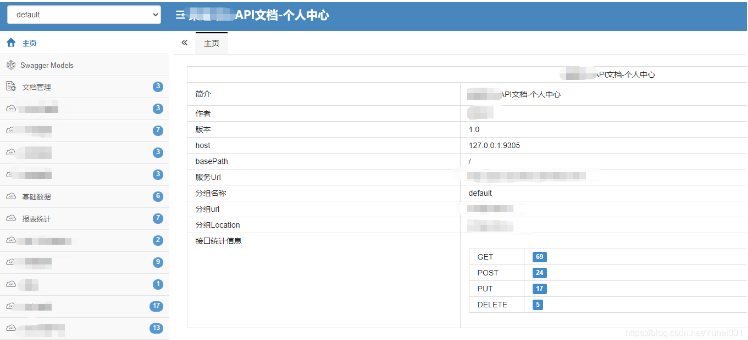
With the popularity of front-end and back-end separation in Internet projects, the front-end and back-end are developed by different personnel, and project communication costs also increase. Increase accordingly.
Mainly reflected in the communication of WebAPI interfaces, Swagger2 emerged as the times require. It can dynamically generate Api interface documents, reduce communication costs, and promote efficient project development.
Let’s discuss the integration of Swagger2 and swagger-bootstrap-ui on SpringBoot
<dependency>
<groupId>io.springfox</groupId>
<artifactId>springfox-swagger2</artifactId>
<version>2.8.0</version>
</dependency>
<dependency>
<groupId>io.springfox</groupId>
<artifactId>springfox-swagger-ui</artifactId>
<version>2.8.0</version>
</dependency>You can make corresponding modifications
@Configuration
@EnableSwagger2
@EnableSwaggerBootstrapUI
@Profile({"dev","test"})
public class Swagger2Config {
@Bean
public Docket createRestApi() {
return new Docket(DocumentationType.SWAGGER_2)
.groupName("") //指定分组,对应(/v2/api-docs?group=)
.pathMapping("") //base地址,最终会拼接Controller中的地址
.apiInfo(apiInfo())
.select()
//为当前包路径
// .apis(RequestHandlerSelectors.any())
.apis(RequestHandlerSelectors.basePackage("com.riskeys.sd.custom"))
.paths(PathSelectors.any())
.build();
}
//构建 api文档的详细信息函数
private ApiInfo apiInfo() {
return new ApiInfoBuilder()
//页面标题
.title("XXX API对接文档")
.description("XX API对接文档") //描述
//创建人
.contact(new Contact("yuhei001", "https://blog.csdn.net/Yuhei0", "18616591658@163.com"))
//版本号
.version("1.0")
//描述
.description("API 描述")
.build();
}
}http://127.0.0.1:10086/swagger-ui.html

Perform the following operations based on step 2
<dependency>
<groupId>com.github.xiaoymin</groupId>
<artifactId>swagger-bootstrap-ui</artifactId>
<version>1.9.6</version>
</dependency>If not configured, access error.9996 may be reported.
Implement the WebMvcConfigurer interface, or WebMvcConfigurationSupport (old version of SpringBoot), implement the addResourceHandlers method, and add the following code.
@Configuration
public class AppWebConfig extends WebMvcConfigurationSupport{
@Override
public void addResourceHandlers(ResourceHandlerRegistry registry) {
registry.addResourceHandler("/swagger-ui.html").addResourceLocations("classpath:/META-INF/resources/");
// 解决 doc.html 404 报错
registry.addResourceHandler("/doc.html").addResourceLocations("classpath:/META-INF/resources/");
registry.addResourceHandler("/webjars/**").addResourceLocations("classpath:/META-INF/resources/webjars/");
}
}or
@Configuration
public class AppWebConfig extends WebMvcConfigurationSupport{
@Override
public void addResourceHandlers(ResourceHandlerRegistry registry) {
registry.addResourceHandler("/swagger-ui.html").addResourceLocations("classpath:/META-INF/resources/");
// 解决 doc.html 404 报错
registry.addResourceHandler("doc.html").addResourceLocations("classpath*:/META-INF/resources/");
registry.addResourceHandler("/webjars/**").addResourceLocations("classpath*:/META-INF/resources/webjars/");
}
}In addition, you can also implement rewriting on the startup class
@SpringBootApplication
public class XXXApplication implements WebMvcConfigurer{
@Override
public void addResourceHandlers(ResourceHandlerRegistry registry) {
registry.addResourceHandler("doc.html").addResourceLocations("classpath*:/META-INF/resources/");
registry.addResourceHandler("/webjars/**").addResourceLocations("classpath*:/META-INF/resources/webjars/");
}
}Access http:// 127.0.0.1:10086/doc.html, compared to swagger-ui.html, this document is cleaner.

swagger generates interface documents through annotations, including interface names, request methods, parameters, return information, etc.
1.1 @EnableSwagger2 Enable Swagger
Actuates the configuration class or startup class
1.2 @EnableSwaggerBootstrapUI Turn on the SwaggerBootstrapUi enhanced function
Acts on the configuration class or startup class. If you do not use the enhanced function, you do not need to enable it.
2.1 @Api: Modify the entire class and describe the role of Controller
value and tags are descriptions. Tags can be used instead of value
@Api(value = "保险公司列表查询", tags = {"保险公司列表查询"})2.2 @ApiOperation() is used for methods; represents the operation of an http request
@ApiOperation(value = "信息员保存(注册)/更新", tags = {"信息員保存"}, notes = "messenger desc")2.3 @ApiParam is used Method, parameter, field description; indicates the added metadata for the parameter (description or whether it is required, etc.)
Applies to a single parameter
@ApiParam(name="sdMessengerInfo",value="参数描述",required=true)
2.4 Request parameter annotation, which can be combined
@ApiImplicitParams is used for methods and contains multiple @ApiImplicitParam
@ApiImplicitParam is used for methods, Represents separate request parameters
Suitable for describing multiple parameters
Example:
// 组合使用
@ApiImplicitParams ({
@ApiImplicitParam(name = "id", value = "参数中文描述", required = true)
})
// 单独使用
@ApiImplicitParam(paramType="query", name="id", dataType="String", required=true, value="参数描述")Note that when @ApiParam and @ApiImplicitParam exist at the same time When, the description of @ApiImplicitParam shall prevail.
2.5 @ApiIgnore() Used on classes or methods, it does not need to be displayed on the page by swagger, and is rarely used.
2.6 Response configuration
@ApiResponses
##@ApiResponse
// 单独配置
@ApiResponse(code = 400, message = "Invalid user supplied")
// 组合使用
@ApiResponses({ @ApiResponse(code = 400, message = "Invalid Order") })@ResponseHeader Response header settings
@ResponseHeader(name="head1",description="response head conf")
@ApiModel Used for classes; indicates description of the class, used to receive parameters using entity classes.
@ApiModel(value = "demo", description = "对象描述")
@ApiModelProperty Used for methods and fields; indicates description of model attributes or data operation changes
@ApiModelProperty(value = "用户id",name = "openid2",dataType = "String", required = true, hidden = true)
value–Field description
–Rewrite attribute name
–Override attribute type
The above is the detailed content of SpringBoot project integrates Swagger and swagger-bootstrap-ui and what are the common annotations?. For more information, please follow other related articles on the PHP Chinese website!
 SpringBoot project building steps
SpringBoot project building steps
 How to use Swagger
How to use Swagger
 What is the difference between j2ee and springboot
What is the difference between j2ee and springboot
 Big data analysis tools
Big data analysis tools
 What is the encoding used inside a computer to process data and instructions?
What is the encoding used inside a computer to process data and instructions?
 Why the computer keeps restarting automatically
Why the computer keeps restarting automatically
 OuYi withdrawal method
OuYi withdrawal method
 Reasons for session failure
Reasons for session failure




